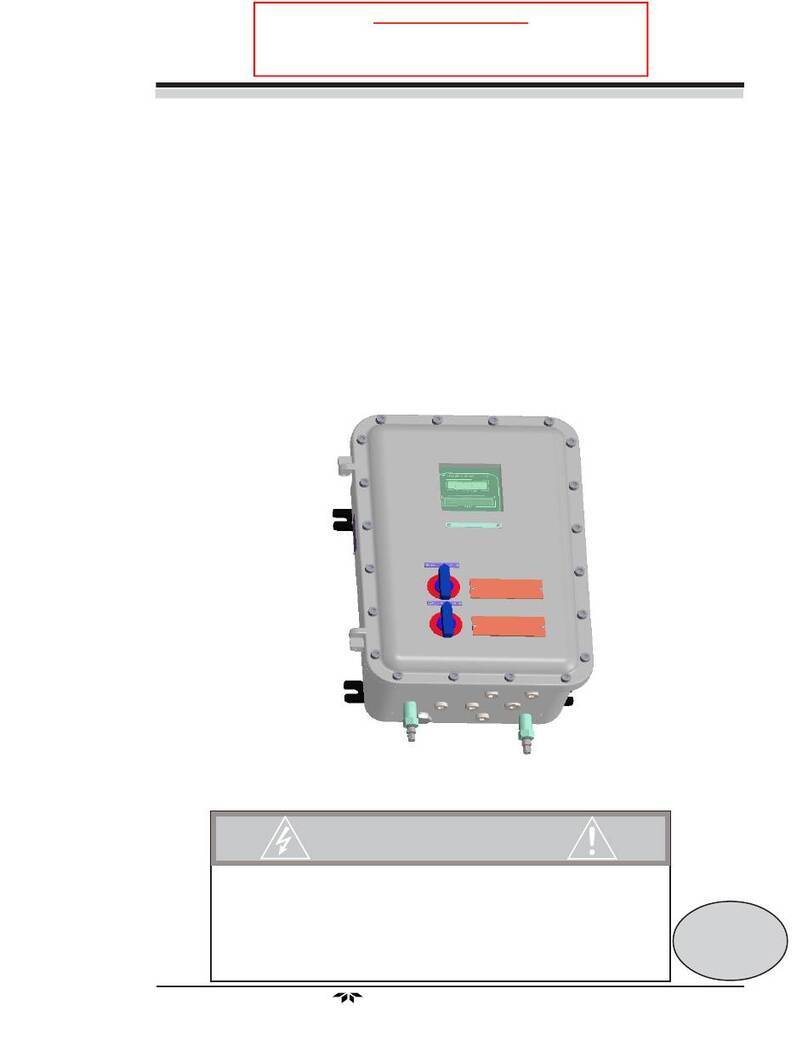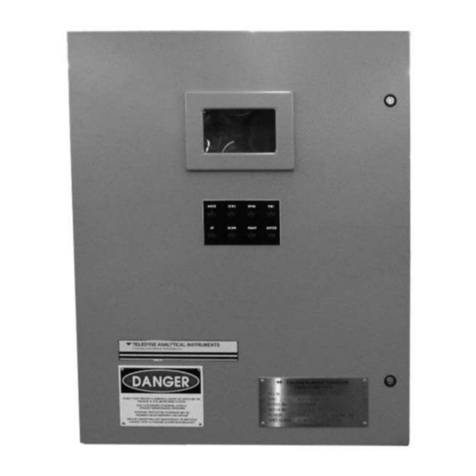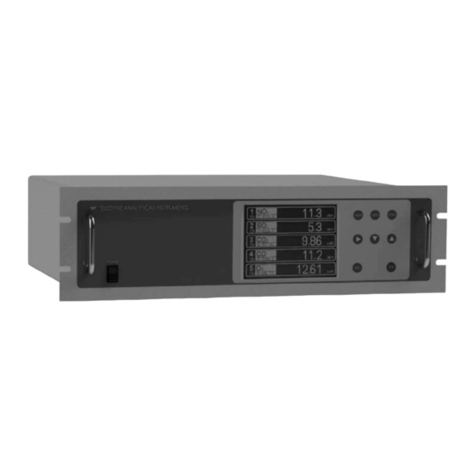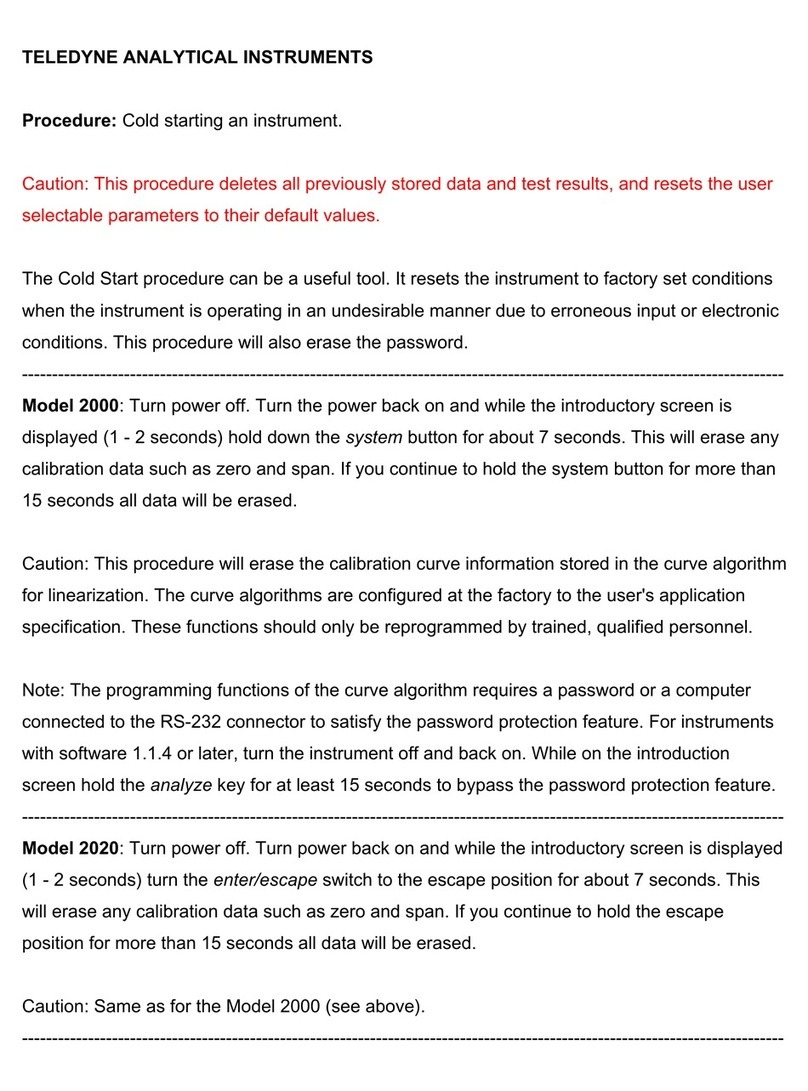
Table of Contents Model GFC7002T N2O Analyzer
Teledyne Analytical Instruments viii
3.4.4. Initial Calibration.............................................................................................................................. 51
3.4.4.1. Interferents for N2O Measurements........................................................................................... 51
3.4.4.2. Initial Calibration Procedure...................................................................................................... 53
3.4.4.3. O2Sensor Calibration Procedure .............................................................................................. 58
3.4.4.4. CO2Sensor Calibration Procedure............................................................................................ 58
PART II OPERATING INSTRUCTIONS.................................................................................. 59
4. OVERVIEW OF OPERATING MODES............................................................................... 61
4.1. Sample Mode........................................................................................................................................ 62
4.1.1. Test Functions................................................................................................................................. 62
4.1.2. Warning Messages.......................................................................................................................... 65
4.2. Calibration Mode ................................................................................................................................... 66
4.3. Setup MODE......................................................................................................................................... 67
4.3.1. Password Security........................................................................................................................... 67
4.3.2. Primary Setup Menu........................................................................................................................ 67
4.3.3. Secondary Setup Menu (SETUP>MORE) ........................................................................................ 68
5. SETUP MENU .................................................................................................................. 69
5.1. SETUP CFG: Configuration Information ............................................................................................ 69
5.2. SETUP ACAL: Automatic Calibration................................................................................................. 70
5.3. SETUP DAS: Internal Data Acquisition System .................................................................................. 70
5.4. SETUP RNGE: Analog Output Reporting Range Configuration.......................................................... 70
5.4.1. Analog Output Ranges for N2O Concentration.................................................................................. 70
5.4.2. Physical Range vs Analog Output Reporting Ranges ....................................................................... 71
5.4.3. Reporting Range Modes: Single, Dual, Auto Ranges........................................................................ 72
5.4.3.1. SINGLE Range Mode (SNGL) .................................................................................................. 74
5.4.3.2. DUAL Range Mode (DUAL)...................................................................................................... 75
5.4.3.3. AUTO Range Mode (AUTO) ..................................................................................................... 77
5.4.4. Range Units..................................................................................................................................... 79
5.4.5. Dilution Ratio (Option)...................................................................................................................... 80
5.5. SETUP PASS: Password Protection.................................................................................................. 81
5.6. SETUP CLK: Setting the Internal Time-of-Day Clock and Adjusting Speed........................................ 83
5.6.1.1. Setting the Internal Clock’s Time and Day................................................................................. 83
5.6.1.2. Adjusting the Internal Clock’s Speed......................................................................................... 83
5.6.2. ID (Machine Identification)................................................................................................................ 85
5.6.3. INET (Ethernet)................................................................................................................................ 85
5.6.4. COM1 and COM2 (Mode, Baud Rate and Test Port)........................................................................ 85
5.7. SETUP VARS: Variables Setup and Definition.................................................................................... 85
5.8. SETUP Diag: Diagnostics Functions................................................................................................... 87
5.8.1. Signal I/O......................................................................................................................................... 90
5.8.2. Analog Output.................................................................................................................................. 91
5.8.3. Analog I/O Configuration.................................................................................................................. 91
5.8.3.1. Analog Output Calibration......................................................................................................... 96
5.8.3.2. Enabling or Disabling the AutoCal for an Individual Analog Output............................................ 96
5.8.3.3. Automatic Calibration of the Analog Outputs............................................................................. 97
5.8.3.4. Individual Calibration of the Analog Outputs.............................................................................. 99
5.8.3.5. Manual Calibration of the Analog Outputs Configured for Voltage Ranges............................... 100
5.8.3.6. Manual Adjustment of Current Loop Output Span and Offset .................................................. 102
5.8.3.7. Turning an Analog Output Over-Range Feature ON/OFF........................................................ 105
5.8.3.8. Adding a Recorder Offset to an Analog Output........................................................................ 106
5.8.3.9. AIN Calibration ....................................................................................................................... 107
5.8.3.10. Analog Inputs (XIN1…XIN8) Option Configuration................................................................. 108
5.8.4. Electrical Test................................................................................................................................ 108
5.8.5. Dark Calibration............................................................................................................................. 109
5.8.6. Pressure Calibration ...................................................................................................................... 109
5.8.7. Flow Calibration............................................................................................................................. 109
5.8.8. Test Chan Output .......................................................................................................................... 110































